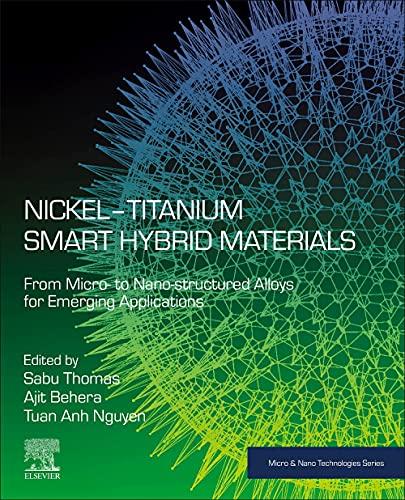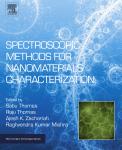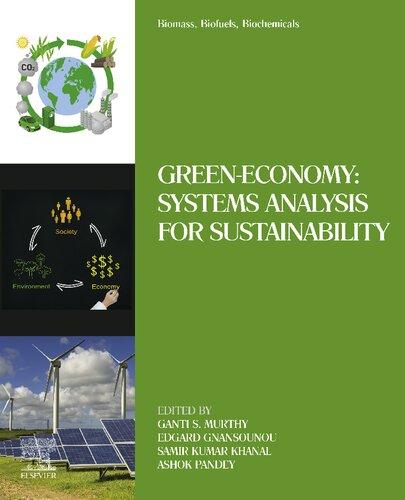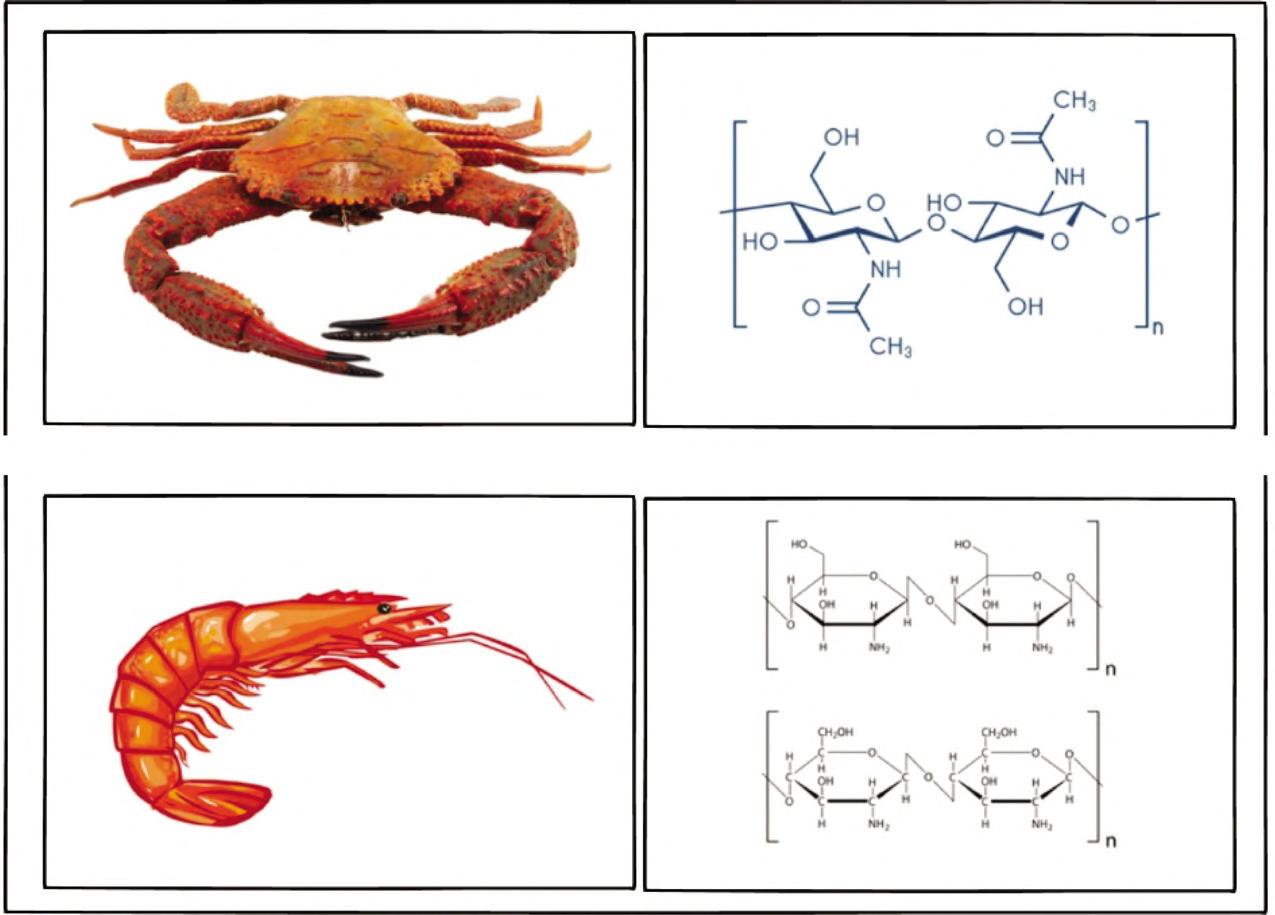Green Micro- and Nanocomposites
edited by Sabu Thomas
Abitha V. K.
Hanna J. Maria
Published by
Jenny Stanford Publishing Pte. Ltd.
101 Thomson Road
#06-01, United Square
Singapore 307591
Email: editorial@jennystanford.com
Web: www.jennystanford.com
British Library Cataloguing-in-Publication Data
A catalogue record for this book is available from the British Library.
Green Micro- and Nanocomposites
Copyright © 2024 by Jenny Stanford Publishing Pte. Ltd.
All rights reserved. This book, or parts thereof, may not be reproduced in any form or by any means, electronic or mechanical, including photocopying, recording or any information storage and retrieval system now known or to be invented, without written permission from the publisher.
For photocopying of material in this volume, please pay a copying fee through the Copyright Clearance Center, Inc., 222 Rosewood Drive, Danvers, MA 01923, USA. In this case permission to photocopy is not required from the publisher.
ISBN 978-981-4968-79-9 (Hardcover)
ISBN 978-1-003-42756-8 (eBook)
1. Green Micro- and Nanocomposite Materials 1
Abitha V. K., Ajay Vasudeo Rane, Deepti Yadav, Hanna J. Maria, and Sabu Thomas
2. Biodegradability of Green Composites: Mechanisms and Evaluation Methods 11
Nikushi S. Yatigala, Dilpreet S. Bajwa, Sreekala G. Bajwa, and Saptaparni Chanda
Green Polymers
Degradation of Biopolymers
Biodegradation
2.4.1 Biodegradation Mechanism Steps Standard Testing Methods of Biodegradation
Biodegradation Properties of Biopolymers and Composites
Biodegradation of PLA-Based Composites
Biodegradation of PHB and PHBV-Based Composites
3. Green Composites Reinforced
L. A. Granda, Q. Tarrés, F. X. Espinach, J. A. Méndez, and M. Delgado-Aguilar 3.1 Cellulose: From
4.5
Preparation of Rubber-Based Chitin and Chitosan Composite
Preparation of Micro Chitin and Chitosan Composites
Preparation of Nano Chitin and Chitosan Composites Applications of Chitin/Chitosan-Based Composites
4.8.1 Tissue Engineering
4.8.2 Drug Delivery
4.8.3 Wound Healing
4.8.4 Protein and Gene Delivery
4.8.5 Dentistry
4.8.6 Food Packaging Applications 4.8.7
5. Green Composites Based on Polyhydroxyalkanoates
Mufaro Moyo, Ajay Vasudeo Rane, Gbadeyan O. Joseph, and Krishnan Kanny
5.1 Introduction
5.2 Sources and Classes of Polyhydroxyalkanoate Composites
5.3 Processing of Green PHA Composites
5.3.1 PHA-Based Microcomposites
5.3.2 PHA-Based Nanocomposites
5.4 Properties of PHA Composites
5.5 Advantages of PHA Composites
5.5.1 Advantages of Green PHA Composites
5.5.2 Disadvantages of Green PHA Composites
5.6 Applications of PHA Composites
5.6.1 Applications of PHA Microcomposites
5.6.2 Applications of PHA Nanocomposites
5.7 Recent Developments in Green PHA Composites
5.8
6. Green Composites
Ajay Vasudeo Rane, Deepti Yadav, Anupam Glorious Lobo, Sabana Ara Begum, P. Santhana Gopala Krishnan, Aswathy J. S., and Krishnan Kanny
6.1 Introduction
6.2 6.3
6.4
6.5
6.6
7.
Sabana Ara Begum, Ajay Vasudeo Rane, Deepti Yadav, P. Santhana Gopala Krishnan, Treesa Reji, and Krishnan Kanny
7.1 Introduction to Proteins and Protein
7.2 Composites Processing
7.2.1
7.2.2
8.
R. Mincheva, S. Benali, and J.-M. Raquez
8.1
8.3 Polysaccharide Nanoparticles
Polysaccharide Nanoparticles via Grafting
8.3.5.1
Preface
In recent years, there has been a growing global concern about the environmental impact of materials and on the urgent need for sustainable solutions. In response to this challenge, the field of green materials has emerged as a promising avenue for developing ecofriendly alternatives that minimize the ecological footprint while maintaining or even enhancing performance. One such area of research is the development of green micro- and nanocomposites, which combines the principles of green chemistry and advanced materials science to create sustainable and functional materials.
This book provides a comprehensive overview of the stateof-the-art advancements in the field of environmentally friendly micro- and nanocomposite materials. It brings together the collective knowledge and expertise of researchers and practitioners from various disciplines, including materials science, chemistry, engineering, and sustainability.
The objective of this book is to provide a comprehensive overview of green micro- and nanocomposites, offering a holistic understanding of their synthesis, properties, and applications. It encompasses a wide range of aspects, including green synthesis methods, characterization techniques, mechanical and thermal properties, electrical conductivity, and barrier performance of micro- and nanocomposites.
Chapter 1, Green Micro- and Nanocomposites, serves as an introduction to the subject, discussing the importance of green composites and their potential to revolutionize various industries. It sets the stage for the subsequent chapters, which delve deeper into specific aspects of green composites.
Chapter 2, Biodegradability of Green Composites: Mechanisms and Evaluation Methods, explores the fascinating world of biodegradability, examining the mechanisms involved and the methods used to evaluate the biodegradation potential of these materials. Understanding the biodegradability of green composites is crucial for their sustainable use in various applications.
Chapter 3, Green Composites Reinforced with Cellulose, focuses on the utilization of cellulose, a renewable and abundant resource, as a reinforcement in green composites. The chapter discusses the preparation, properties, and applications of cellulose-based composites, highlighting their unique advantages and challenges.
Chapter 4, Green Composites Reinforced with Chitin and Chitosan, explores the potential of chitin and chitosan, natural polymers derived from shellfish, as reinforcements in green composites. The chapter investigates the properties, processing techniques, and applications of these composites, shedding light on their immense potential in various industries.
Chapter 5, Green Composites based on Polyhydroxyalkanoates, focuses on the applications of polyhydroxyalkanoates (PHAs), biodegradable and biocompatible polyesters produced by microorganisms, in green composites. The chapter delves into the synthesis, properties, and applications of PHA-based composites, providing insights into their wide-ranging uses.
Chapter 6, Green Composites Based on Poly(Lactic Acid), explores the utilization of poly(lactic acid) (PLA), a renewable and biodegradable polymer derived from plant sources, in green composites. The chapter discusses the processing techniques, properties, and applications of PLA-based composites, highlighting their potential to replace conventional petroleum-based materials.
Chapter 7, Green Composites Based on Protein Materials, examines the use of protein materials, such as soy protein, zein, and gluten, as reinforcements in green composites. The chapter explores the preparation methods, properties, and applications of proteinbased composites, emphasizing their biocompatibility and potential applications in the biomedical field.
Chapter 8, Surface Modification of Biobased Polysaccharide Nanoparticles via Grafting, focuses on the surface modification techniques employed to enhance the properties and performance of biobased polysaccharide nanoparticles. The chapter discusses various grafting methods and their impact on the composite materials, paving the way for tailored properties and applications. This book will be a valuable resource for researchers, scientists, engineers, and professionals interested in the development and applications of green micro- and nanocomposites. By providing a comprehensive understanding of the synthesis, properties,
xiii Preface
and applications of these materials, it aims to inspire further advancements in the field and contribute to a sustainable future.
We acknowledge the collaborative effort of the authors, editors, and reviewers who have contributed to this book. Their expertise and dedication have ensured the quality and relevance of the content of the book.
Sabu Thomas Abitha V. K. Hanna J. Maria Summer 2023
Green Micro- and Nanocomposite Materials
Abitha V. K.,a Ajay Vasudeo Rane,b Deepti Yadav,c Hanna J. Maria,d and Sabu Thomasa,d,e
aSchool of Chemical Sciences, Mahatma Gandhi University, Kottayam-686560, Kerala, India
bComposite Research Group, Department of Mechanical Engineering, Durban University of Technology, Durban-4000, South Africa
cDepartment of Biotechnology and Food Science, Durban University of Technology, Durban-4000, South Africa
dSchool of Energy Materials, Mahatma Gandhi University, Kottayam-686560, Kerala, India
eInternational and Inter University Centre for Nanoscience and Nanotechnology, Mahatma Gandhi University, Kottayam-686560, Kerala, India
abithavk@gmail.com
Environmental issues throughout the world such as rising sea levels, rising average global temperatures, melting polar ice caps, and fast depleting petroleum resources have increased the burden on individuals and industries to find alternative resources to fulfil their
Green Micro- and Nanocomposites
Edited by Sabu Thomas, Abitha V. K., and Hanna J. Maria
Copyright © 2024 Jenny Stanford Publishing Pte. Ltd.
ISBN 978-981-4968-79-9 (Hardcover), 978-1-003-42756-8 (eBook) www.jennystanford.com
demands (Fig. 1.1). Key global challenges include how to respect the environment and enhance living conditions for the benefit of all living organisms. These concerns, combined with a growing understanding of renewable “green” resources, have prompted several sectors to take steps to reduce their harmful impact on the environment.
In order to overcome the challenges, there is a demand for sustainably produced green materials with competitive abilities, with an emphasis to reduce the harmful impact on the environment. The global research on composites produced using green materials makes this area of research more enduring and powerful, with its contribution to reducing harmful impact on the environment using a sustainable approach. This chapter discusses the brief on the chapters, on composites and nanocomposites produced from green materials. The word “green” here refers to sustainable materials which are available in abundance and are left untouched as waste.
In recent years, sustainable development has become a major issue, and the looming depletion of oil-based resources will necessitate the usage of biomaterials derived from renewable resources. The widely accepted definition of sustainable development is “development that meets current demands without jeopardising future generation’s ability to meet their own needs.” In a broader sense, sustainable development is made up of three elements: society, the environment, and the economy. Hence, green composites are and form an essential part of sustainable development owing to their applications in different fields.
Biodegradation is the process of converting organic substrates (polymers) into low molecular weight fragments that may then
Figure 1.1 Environmental issues throughout the world.
be degraded to carbon dioxide and water using the activities of microbial species (Fig. 1.2). Biodegradation is influenced by a polymer’s physical and chemical characteristics. The biodegradation mechanism of green composites and its evaluation methods are discussed in Chapter 2. Different standard testing methods used for biodegradation such as visual inspection, quantitative estimation of weight loss of the polymer, changes in properties such as a change in molecular weight, functional groups, crystallinity, tensile strength, measurement of CO2 evolution or O2 consumption, radiolabelling, and clear zone formation are discussed. Furthermore, the authors have discussed the biodegradation mechanisms of PLA (poly(lactic acid)), PHB, PHBV, and polymers extracted from biomass-based compounds [1, 2].

Cellulose is a polysaccharide made up of linear glucan chains linked by β-1,4 glycosidic bonds with cellobiose residues as the repeating units at various degrees of polymerization and packed into microfibrils held together by intramolecular hydrogen bonds and intermolecular van der Waals forces (Fig. 1.3). Green plants, algae, and oomycetes all have cellulose as a structural component of their major cell walls. Some bacteria emit it in order to create a biofilm. The most common organic polymer on the planet is cellulose. Cotton fiber has a cellulose percentage of 90%, wood has a cellulose level of 40–50%, and dry hemp has a cellulose content of around 57%. Chapter 3 discusses the green composites prepared by and/or using cellulose. Green composites made from cellulose offer a unique chance to develop new materials with improved socially acceptable features. According to the literature, these composites currently have sufficient characteristics to match glass fiber-based
Figure 1.2 Process of biodegradation.
composites. Herein, the authors have elaborated on the different types of cellulose reinforcement (in terms of their morphology, production methods, and properties). In addition, thermoplastic, thermoset, and rubber-based composites in respect to their potential use together with micro- and nanostructured cellulosic fibers are also discussed [3, 4].
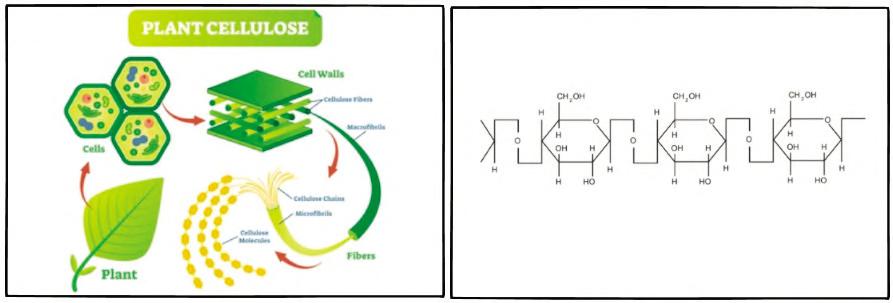
Chitin is a long-chain polymer made up of N-acetyl glucosamine, a glucose amide derivative. It is a key component of the cell walls of fungi, the exoskeleton of arthropods such as crustaceans and insects, and the radulae, cephalopod beaks, and gladii of mollusks and is the second most prevalent polysaccharide in nature (after only cellulose) (Fig. 1.4). At least some fish and Lissamphibia synthesize it as well. Chitin has a structure similar to cellulose, generating crystalline nanofibers or whiskers. It has a similar function to the protein keratin. Chitosan is a linear polysaccharide made up of N-acetyl-D-glucosamine (acetylated unit) and β(1à4)-linked D-glucosamine (deacetylated unit) that are randomly dispersed. Chitosan is manufactured by alkaline treatment of shrimp and other crustaceans’ shells (Fig. 1.4). Chapter 4 discusses the green composites prepared by and/or using chitin and chitosan. Composites made by mixing fillers with biopolymers like chitin or chitosan are very promising materials since they improve characteristics while retaining biodegradability and non-toxicity. The use of hybrid polymer matrices comprising chitosan and other biodegradable polymers has been suggested to improve composite characteristics. Several research investigations reveal that chitosan may be molded into a variety of shapes, including hydrogels, films, powders, and particles, among others. The development of innovative chitosan-
Figure 1.3 Cellulose source and chemical structure.
based polymeric materials is a fascinating way to investigate the applications of chitosan-based composites [5, 6].
Figure 1.4 Chitin, chitosan source, and chemical structure.
Polyhydroxyalkanoates (PHAs) are polyesters created in nature by a variety of microorganisms, including bacteria that digest carbohydrates or lipids. They serve as a source of both energy and carbon storage when created by bacteria. Within this family, more than 150 distinct monomers can be mixed to create materials with a wide range of characteristics (Fig. 1.5). These biodegradable plastics are utilized in the manufacture of bioplastics. Thermoplastic and elastomeric materials with melting points ranging from 40℃ to 180℃ can be used. Blending, changing the surface, or combining PHAs with other polymers, enzymes, and inorganic elements can affect the mechanical properties and biocompatibility of PHAs allowing for a wider range of uses. Chapter 5 discusses the green composites prepared using PHAs. PHAs are biodegradable and biocompatible making them one of a kind composite materials with applications in biomedical research, packaging film, traditional plastics, membrane technology, and electronics. Wet and melt processing techniques can be used to create PHA micro- and nanocomposites. However, their production costs are now expensive, and their processing has several technological issues that must be resolved. Continued research into
Green Micro- and Nanocomposite Materials
the issues connected with green composites based on PHAs could lower production costs and increase output volumes [7, 8].
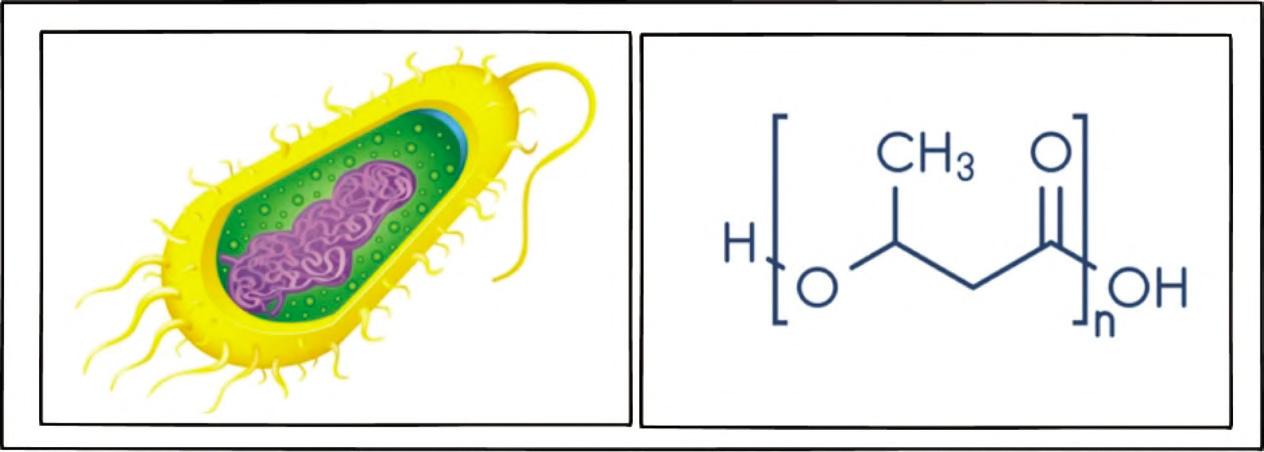
Poly(lactic acid) commonly known as PLA or poly(lactide) is a thermoplastic polyester made by condensing lactic acid with the removal of water (Fig. 1.6). Lactide is the cyclic dimer of the basic repeating unit and can also be produced through ring-opening polymerization. PLA has grown in popularity as a result of its costeffective production from renewable resources. Its widespread use has been hampered by a number of physical and processing flaws. In 3D printing, PLA is the most extensively used plastic filament material. Chapter 6 discusses the green composites prepared using PLA. PLA is a biocompatible and biodegradable polymer that has a wide range of applications. PLA’s use in a variety of industrial applications is predicted to increase dramatically in the next years, making it a cost-effective commodity plastic with the added virtue of being environmentally friendly. PLA is considered a “Green” polymer because it is produced in an environmentally friendly manner and can be used to replace petrochemical-based polymers [9, 10].
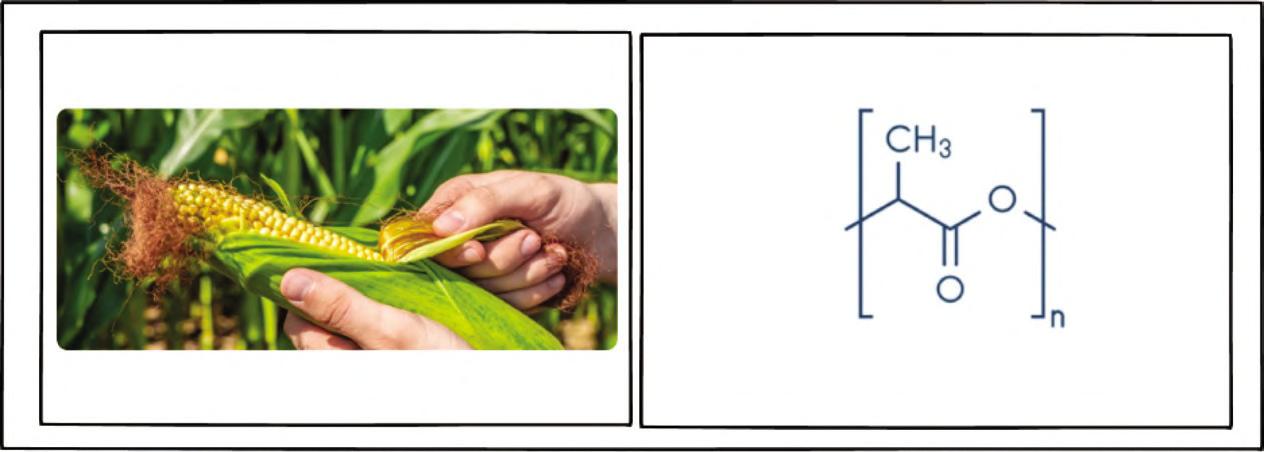
Figure 1.5 PHA source and chemical structure.
Figure 1.6 PLA source and chemical structure.
Protein-based composites provide a plethora of options for customizing material qualities by modifying the protein sequences used to make them or the methods used to make them. Chapter 7 discusses the green composites prepared using proteins. In this chapter, we look at a variety of different applications using a variety of proteins available from natural sources (Fig. 1.7). Proteins have shown promise in terms of intrinsic biodegradability, biocompatibility, natural abundance, and mechanical and functional qualities when compared to other natural polymers such as lignocellulosic components (cellulose, hemicellulose, and lignin) and starch. To summarize, the use of environmentally benign materials with improved properties provides a beneficial chance to partially replace petroleum-based plastics, while increasing the value of the huge natural macromolecules available [11, 12].

Surface modification is the process of altering the surface of a material by adding physical, chemical, or biological features that differ from those found on the surface of the material originally (Fig. 1.8). Different approaches can be used to alter a wide range of surface attributes including roughness, hydrophilicity, surface charge, surface energy, biocompatibility, and reactivity. The current state of grafting approaches for surface modification of biobased
Figure 1.7 Protein sources.
Green Micro- and Nanocomposite Materials
8 Green Micro- and Nanocomposite Materials
polysaccharide nanoparticles, such as nanocelluloses, starch, and chitin nanoparticles, are discussed in Chapter 8 [13, 14].
Figure 1.8 Grafting techniques.
The first section covers the various ways, such as grafting from, grafting onto, grafting through, and supramolecular grafting. The current state of the art in polysaccharide particle formation, physical and chemical properties, and relatively recent trends and methods are also updated. The final section delves into the most recent methodologies and successes in surface-modified nanocelluloses, nanochitin, and nanostarch particles via grafting from, grafting onto, and, most crucially, supramolecular grafting.
References
1. Wan YZ, Luo H, He F, et al. Mechanical, moisture absorption, and biodegradation behaviours of bacterial cellulose fibre-reinforced starch biocomposites. Compos Sci Technol 2009; 69: 1212–1217.
2. Kister G, Cassanas G, Bergounhon M, et al. Structural characterization and hydrolytic degradation of solid copolymers of D, L-lactide-co-εcaprolactone by Raman spectroscopy. Polymer (Guildf) 2000; 41: 925–932.
3. Iwamoto S, Abe K, Yano H. The effect of hemicelluloses on wood pulp nanofibrillation and nanofiber network characteristics. Biomacromolecules 2008; 9: 1022–1026.
4. Alcalá M, González I, Boufi S, et al. All-cellulose composites from unbleached hardwood kraft pulp reinforced with nanofibrillated cellulose. Cellulose 2013; 20: 2909–2921.
References
5. Busila M, Musat V, Textor T, et al. Synthesis and characterization of antimicrobial textile finishing based on Ag:ZnO nanoparticles/ chitosan biocomposites. RSC Adv 2015; 5: 21562–21571.
6. Rinaudo M. Chitin and chitosan: Properties and applications. Prog Polym Sci 2006; 31: 603–632.
7. Ma H, Liu M, Li S, et al. Application of polyhydroxyalkanoate (PHA ) synthesis regulatory protein PhaR as a bio-surfactant and bactericidal agent. J Biotechnol 2013; 166: 34–41.
8. Barkoula NM, Garkhail SK, Peijs T. Biodegradable composites based on flax/polyhydroxybutyrate and its copolymer with hydroxyvalerate. J Ind Crop Prod 2010; 31: 34–42.
9. Rane A V., Kanny K, Mathew A, et al. Comparative analysis of processing techniques’ effect on the strength of carbon black (N220)-filled poly (lactic acid) composites. Strength Mater 2019; 51: 476–489.
10. Rarima R, Unnikrishnan G. Poly(lactic acid)/gelatin foams by nonsolvent induced phase separation for biomedical applications. Polym Degrad Stab 2020; 177: 109187.
11. Tanabe T, Okitsu N, Tachibana A, et al. Preparation and characterization of keratin-chitosan composite film. Biomaterials 2002; 23: 817–825.
12. Lim SW, Jung IK, Lee KH, et al. Structure and properties of biodegradable gluten/aliphatic polyester blends. Eur Polym J 1999; 35: 1875–1881.
13. Habibi Y. Key advances in the chemical modification of nanocelluloses. Chem Soc Rev 2014; 43: 1519–1542.
14. Malmström E, Carlmark A. Controlled grafting of cellulose fibres – an outlook beyond paper and cardboard. Polym Chem 2012; 3: 1702–1713.
Chapter 2
Biodegradability of Green Composites: Mechanisms and Evaluation Methods
Nikushi S. Yatigala,a Dilpreet S. Bajwa,b
Sreekala G. Bajwa,c and Saptaparni Chandab
aAgricultural and Biosystems Engineering, North Dakota State University, Fargo, ND 58108, USA
bMechanical and Industrial Engineering, Montana State University, Bozeman, MT 59718, USA
cCollege of Agriculture, Montana State University, Bozeman, MT 59718, USA dilpreet.bajwa@montana.edu
Petroleum-based plastics cause substantial environmental problems at disposal because of their slow degradation and harmful degradation products. Most of the plastic wastes end up in landfills, creating water and soil pollution. For both water miscible and immiscible polymers that cannot be recycled nor incinerated, biodegradation is crucial as these polymers ultimately enter streams, which cannot be recycled nor incinerated. Biobased biodegradable polymers and natural fibers have a low environmental impact, and they are highly sustainable. They reduce waste accumulation,
Green Micro- and Nanocomposites
Edited by Sabu Thomas, Abitha V. K., and Hanna J. Maria
Copyright © 2024 Jenny Stanford Publishing Pte. Ltd.
ISBN 978-981-4968-79-9 (Hardcover), 978-1-003-42756-8 (eBook) www.jennystanford.com
control carbon dioxide emission, and minimize the dependency on petroleum-based fuels and products. The incorporation of natural fibers into biobased polymers causes an increase in specific strength and degradation rate and cost reduction. During biodegradation, polymers deteriorate their physical and chemical properties decreasing their molecular mass and form CO2, H2O, CH4, and other low molecular weight products. This chapter discusses the current state of knowledge on the behavior of biobased polymers and their composites when subjected to accelerated weathering, ultraviolet, thermal, moisture, water, soil, and aerobic and anaerobic degradation. A range of biobased polymer composites are presented in this chapter, focusing on their degradation characteristics and mechanism, properties, physical and mechanical common standards, and evaluation methods.
2.1 Introduction
Low degradation rates and harmful degradation products such as carbon dioxide (CO2) of synthetic polymers create substantial environmental problems at disposal. These polymers account for roughly 20% by volume of all wastes generated annually in the United States and contribute to global warming [1, 2]. Moreover, at the current rate of consumption, the petroleum that the polymers are created from can only last for another 50–60 years [3]. Owing to the negative impacts of petroleum-based plastics on the environment and ecosystem health, and the uncertain supply of fossil fuels, there is a great potential for replacing synthetic plastics with biodegradable alternatives. Not only do green plastics have a positive impact on the environment, but they also have many other attractive properties such as biocompatibility, bioactivity, chemical inertness, high stiffness and strength, good film-forming properties, and low toxicity [4–6]. For example, PLA, a chemically synthesized biobased polymer, is similar in mechanical properties to petrochemical polymers such as polypropylene and polyethylene [7]. Likewise, PHB, a polymer produced by bacteria, also has similar mechanical properties to polypropylene and higher moisture resistance and aroma barrier properties [8]. Similarly, cellulose, a naturally occurring polymer, is a hard polymer and has a high tensile
strength [9]. When these biodegradable plastics are combined with biobased fibers and fillers to make green composites, their biodegradability generally improves.
Although green biodegradable polymers have numerous benefits, they are restricted in many applications as for their high cost and some of their undesirable properties such as low biodegradation rate, higher crystallinity, sensitivity to thermal degradation, and poor mechanical properties [5, 7, 10–12]. Compared to the waste accumulation rate, the degradation rate of biobased polymers such as PLA is still too slow [13]. The majority of biobased plastics tend to be brittle due to their high crystallinity. As for their thermal sensitivity, most green plastics are sensitive to thermal degradation during conventional melt processing. Reduction of molecular weight occurs as they degrade during thermal processing or under hydrolytic conditions. Mechanical properties of the processed biobased materials are likely to be affected by the reduction of molecular weight [14, 15]. However, mechanical and degradation properties can be changed while reducing cost by creating green composites with biobased polymers and other natural polymers or fillers [7, 12, 16]. Creating polymer blends and composites is a good cost-effective method to improve the properties such as dimensional stability, strength, toughness, and environmental degradation [7, 17]. In addition, mechanical properties of the biopolymer composites can be enhanced with reactive functional groups such as compatibilizers and coupling agents since they improve the adhesion between polymer and the fiber by forming both hydrogen and covalent bonds with hydroxyl groups of fiber and molecular entanglement with polymer [10, 16]. This chapter focuses on the biodegradation properties of biobased composites, how biopolymer composites containing various fiber and polymers behave, the different modes of biodegradation, how environmental conditions affect the biodegradation of these materials, and the standards for quantifying biodegradation properties.
2.2 Green Polymers
Biobased polymers serve as the matrix or substrate material in biocomposites, with natural fibers and other biobased materials
serving as the fillers or reinforcement. It is important to understand the various types of bioplastics and their biodegradation characteristics in order to understand such properties of composites containing biopolymer as the substrate.
Polymers can be produced from various renewable and nonrenewable resources. Green or biobased polymers are the polymers produced by or from living systems. Some examples of green polymers from renewable resources are cellulose, starch, proteins, and DNA. Biodegradable plastics are polymers that will degrade due to the action of microorganisms, such as bacteria and fungi. Biodegradable polymers produced from renewable, biobased resources enjoy a high sustainability score. They reduce waste accumulation, control CO2 emission, and lessen the need for petroleum-based fuels and products [18]. Bioplastics can be classified into biodegradable and nondegradable (Fig. 2.1). For example, biobased polyethylene is not biodegradable. Also, there are synthetic polymers (produced from nonrenewable petroleum resources) that are biodegradable [19]. As Fig. 2.2 illustrates, biodegradable green polymers from renewable resources can be divided into three categories: (i) those synthesized from bio-derived monomers (PLA), (ii) those produced by microorganisms (PHAs, bacterial cellulose), and (iii) those directly extracted from biomass with partial modification to meet the requirements [1, 6]. Table 2.1 provides some examples of naturally occurring polymers.
2.1 Types of bioplastics (adapted from [1]).
Figure
Green Polymers
Figure 2.2 Origin of biobased polymers (adapted from [1]).
Table 2.1 Naturally occurring biodegradable polymers (adapted from [4])
Polyesters
Polyhydroxyalkanoates
Polylactic acid
Proteins
Silks
Collagen/gelatin
Elastin
Resilin
Adhesives
Polyamino acids
Soy zein, wheat gluten
Casein, serum albumin
Polysaccharides (bacterial)
Xanthan
Dextran
Gellan
Levan
Polysaccharides (plant/algal)
Starch (amylose/amylopectin)
Cellulose
Agar
Alginate
Carrageenan
Pectin
Konjac
Various gums (e.g., guar)
Polysaccharides (animal)
Chitin/chitosan
Hyaluronic acid
Lipids/surfactants
Acetoglycerides, waxes, surfactants
Emulsan
Polyphenols
Lignin
(Continued)
Table 2.1 (Continued)
Polyesters
Curdlan
Polygalactosamine
Cellulose (bacterial)
Polysaccharides (fungal)
Pullulan
Elsinan
Yeast glucans
Polysaccharides (plant/algal)
Tannin
Humic acid
Specialty polymers
Shellac
Poly-gamma-glutamic acid
Natural rubber
Synthetic polymers from natural fats
Nylon from castor oil
2.3 Degradation of Biopolymers
There are many types of polymer degradation mechanisms: thermal, mechanical, photochemical, radiation chemical, biological, and chemical degradation [20]. According to ASTM definition, “degradable plastics are the plastics that are designed to undergo a significant change in their chemical structure under specific environmental conditions, resulting in a loss of some properties that may vary as measured by standard methods appropriate to the plastic and the application in a period of time that determines its classification.” This definition can be applied to many polymer degradation types including photodegradation, thermooxidation, hydrolysis, and biodegradation. Autooxidation is the cause of thermooxidative degradation of organic materials without light. In natural photodegradation, the molecular weight of the polymers is decreased by sunlight due to photooxidation and direct bond cleavage [21]. Another mode of degradation is hygrothermal degradation. Substantial loss of weight and mechanical properties of a material due to the effects of moisture and temperature is called hygrothermal degradation [22]. In nature, to decompose organic matter, biotic and abiotic factors act synergistically. Some biodegradation studies show that abiotic degradation precedes microbial assimilation [23–25]. Exposing polymers to naturally degrading environmental conditions (weather, aging, and burying) results in different transformations of polymers due to light, thermal,
Biodegradation
and chemical agents. These abiotic parameters are useful factors in initiating the biodegradation process, as these parameters help to weaken the polymer structures [25, 26]. Some other mechanisms of polymer degradation include the following:
(i) Chemical degradation: It occurs when the polymers are brought to contact with chemicals such as acids, bases, and solvents. Oxygen is the most important as it attacks covalent bonds creating free radicals [20].
(ii) Thermal degradation: It is the molecular deterioration of polymer due to heat. For thermoplastics, this occurs at the melting temperature. The components of the polymer backbone chain detach (molecular scission) and react with each other resulting in changed polymer properties.
(iii) Mechanical degradation: Macroscopic changes occur in polymer material due to compression, tension, and shear forces. Under shear forces, molecular interaction between certain molecules at certain sites gets disrupted.
(iv) Photodegradation: In photodegradation, polymers undergo physical and chemical changes due to ultraviolet light or visible light, inducing cross-linking/Norrish reactions, or oxidative processes.
2.4 Biodegradation
During biodegradation, living organisms break down organic substances, and thus the chemical structure of the material changes resulting in the production of carbon dioxide, water, and new microbial cell mass. Only biodegradation or biological degradation completely removes the polymer or its degradation products from the environment. It takes about 1–3 years to completely assimilate and disappear a biodegradable plastic article [21]. Biodegradation can occur under two different conditions: aerobic and anaerobic. Polymers can be attacked by living organisms either chemically or mechanically. Enzymes are involved in the chemical mode while the mechanical mode refers to the attack by mammals and insects [20]. Enzymes are proteins of complicated chemical structures. Typically, the catalytic activity of enzymes is related to a special molecular conformation. Depending on the properties of the biopolymer, the
biodegradation of plastics proceeds under different soil conditions actively due to ideal growth conditions of microorganisms in the soil [15].
In biodegradation, microbes such as bacteria and fungi are engaged in the degradation of both bio- and petroleum-based plastics. Bacteria involved in the biodegradation process include, inter alia, Bacillus, Pseudomonas, Klebsiella, Actinomycetes, Nocardia, Streptomyces, Thermoactinomycetes, Micromonospora, Mycobacterium, Rhodococcus, Flavobacterium, Comamonas, Escherichia, Azotobacter, and Alcaligenes (some of them are capable of consuming polymer about 90% of their dry mass). Fungi active in the biodegradation process are Sporotrichum, Talaromyces, Phanerochaete, Ganoderma, Thermoascus, Thielavia, Paecilomyces, Thermomyces, Geotrichum, Cladosporium, Phlebia, Trametes, Candida, Penicillium, Chaetomium, and Aerobasidium [27].
Biodegradation depends on many factors such as the type of organism, pretreatment method, polymer characteristics such as mobility, molecular weight, crystallinity, and plasticizers or additives blended with the polymer. For instance, higher molecular weight lowers the solubility of the polymer, reducing the microbial attack, and the rate of degradability [15]. The insolubility of polymers reduces the availability of digestible substrates through bacterial cellular membrane.
As opposed to degradable/biodegradable synthetic plastics, biodegradable green polymers/composites generally do not produce toxic products, or it is much less compared to synthetic plastics. Biodegradable green composites are not necessarily easy to decompose, and they require certain environmental conditions. Even then, they may leave behind toxic residues. There are three types of degradable plastics:
(1) Degradable: Plastics will undergo a significant change in their chemical structure under certain environmental conditions resulting in a loss of some properties.
(2) Biodegradable: Plastics will degrade due to microbial activity producing CO2, water, and biomass as end products. There is no requirement for leaving “no toxic residue,” nor for the time it needs to take to biodegrade. Thus, “biodegradable”


